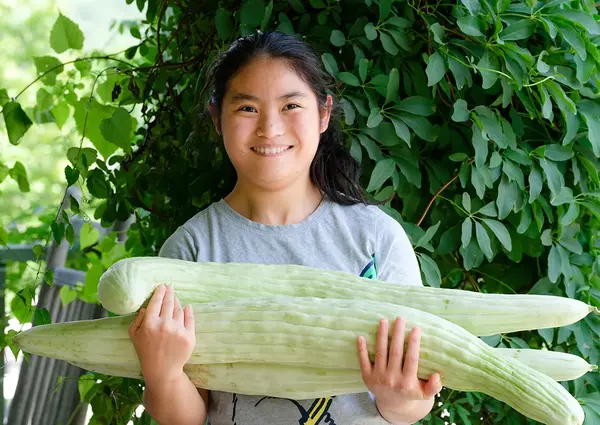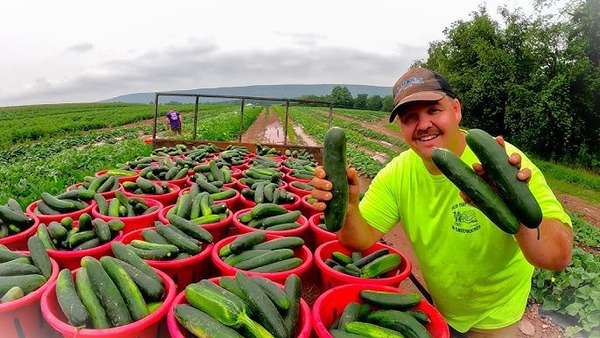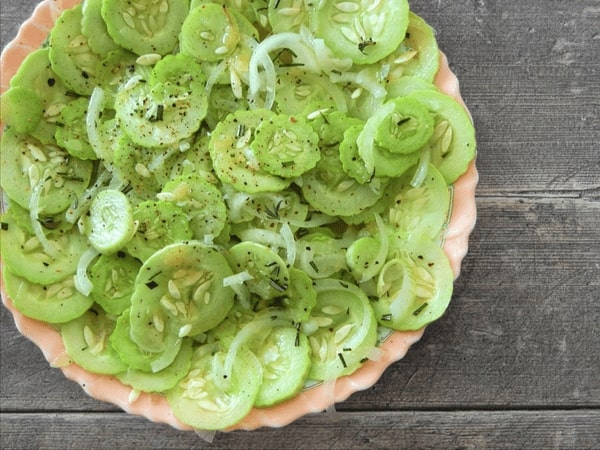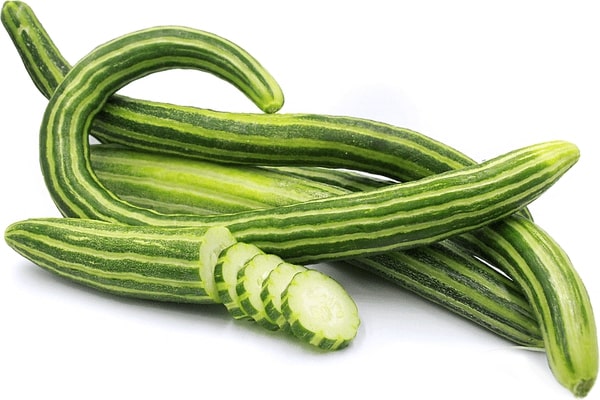Armenian cucumber looks like a cucumber and tastes like one but it is not actually a cucumber. They are in the same genus as cucumbers but actually belong to a separate species which are more closely related to muskmelons. This makes them Armenian cucumber melons. Sounds confusing, right? Read the complete article below to get all the answers to your questions.
What are Armenian Cucumbers?
Armenian cucumber melons look like a cucumber but unlike cucumbers, they are bent, not straight. These cucumbers are characterized by soft flesh, thin skin, and a line of small seeds that can be removed easily.
These fruits start out lush green in color and then slowly turn yellow when ripe. It has a sweet and refreshing taste.
These plants have angular stems which also have fine hairs. The leaves are profuse.
The cucumbers are harvested when they are between 8 to 10 inches long even though they can grow up to three feet in length.
These fruits grow vertically on trellises and tunnels but the plants can also be sprawled along the ground. Those plants which are grown on the ground are more curved whereas the ones grown vertically are straighter.

Types of Armenian Cucumbers
There are several varieties of Armenian cucumbers. Some of the most popular ones are listed below:
- Light green – The most common and widely available variety of Armenian cucumbers. They are pale green colored and grow two to three feet long.
- Dark green – These are a little harder to find than light green ones but are becoming more common these days. They are dark green.
- Striped Armenian Cucumbers– Also known as Painted Serpent, this variety has long, slender fruits with dark green and light green stripes. They’re harvested when they are 8 to 15 inches long.
- Carosello Barese – These are Italian ones that have the same flavor as the Armenian cucumbers but are compact and oval-shaped. They are harvested when they’re four inches long.
- Mandurian Round Carosello – These plants are compact and bushy,with the skin being streaked in dark and light green while the flesh is mild. They are harvested when the fruits are two to three inches across.
You may also like to read: Growing Lettuce 101: Your Guide to Crisp, Fresh Salads All Season Long
Growth and Care Tips for Armenian Cucumbers
1. Planting at the right time
These plants thrive in hot climates as they tolerate higher temperatures. Traditional cucumbers struggle in warmer regions. They are one of the few vegetables that can be planted through July.
- Start seeds indoors From February to June
- Plant outside from March to July
2. Choosing the right location
Here are some tips for choosing the proper location for this plant:
- Choose a place that gets at least 6-8 hours of sunlight per day
- They thrive on some sort of trellis that keeps them off the ground.
- Avoid overcrowding. Crowded ones tend to attract more pests and diseases. Allow at least a foot.
- Do not plant in the same area you previouslu planted other melons, cucumbers, or squash.
3. Pruning Armenian Cucumbers
Since yellow leaves can drain energy from the plant, make sure you cut them off.
Pruning can improve air circulation and sunlight exposure. Here are the steps you could follow for the pruning process:
- Firstly, locate the main vine of the plant. The thickest and longest vine that grows from the base of the plant is the main vine.
- Then, find a side shoot that is growing from the base of a leaf stem.
- Finally, cut the side shoot around 1/4 inch above the main vine.
Don’t remove all the side shoots as a few shoots could help in maintaining the structure and balance of the plant.
4. Harvesting Armenian Cucumbers
Since Armenian cucumbers are incredible producers, they will continue to produce fruits throughout the season if you make sure you harvest them regularly. So, don’t be afraid of harvesting them as you could have fresh fruits all summer.

Here are some harvesting tips for these “cucumbers”:
-
As mentioned above, there are several varieties of this plant and some can grow to 3 feet long quickly. For these varieties, pick them when they are around 12-18 inches long and 2 ½” in diameter.
-
To lengthen storage time, pick the fruits early in the day and keep them in a bowl filled with ice water.
-
Pulling can damage the vine so just cut the fruit off.
-
As mentioned earlier, you should harvest them regularly and they keep producing. However, if you leave the fruit on the vine too long, it slows or stops production.
Larger fruits taste more like a watermelon and less like a cucumber making it even more less like a “cucumber” as its name suggests.
How can you eat Armenian cucumbers?
Armenian cucumbers are actually very tasty. They have mild, slightly sweet flavor and also lack the bitterness that we associate cucumbers with. Because of these reasons, it could be a great option to add in several dishes
Eating these fruits fresh by just cutting them is always a good idea as it leaves you fresh and wanting for more. However, there are several other ways you could use these fruits.

Two of the most common ways to eat these fruits are by including them in salads and sandwiches. Even when cooked, they tend to maintain their crunch when and can be a great addition to grilled or stir-fried vegetable dishes.
Here are some tips and ways you could enjoy these fruits:
- You don’t need to peel the skin of young Armenian cucumbers as they are thin and edible.
- You could add these cucumbers in salad, dips, sushi, or sandwiches.
- Another option could be grilling them in vegetable kabobs.
- You could also add them in smoothies.
- Goes well with fish, pork, mint, oregano, yogurt, and feta cheese.
FAQs:
-
What is Armenian Cucumbers’ temperature tolerance?
These plants thrive in hot climates as they tolerate higher temperatures. They thrive in regions above 50 degrees Fahrenheit (10 C).
2. Can you grow them in pots?
Yes! The Armenian cucumbers can be grown in pots. However, the key here is to choose a container that is at least 16 inches across. The bigger, the better.
3. What are companion plants of the Armenian cucumbers?
Corn is the most popular companion plants of the Armenian cucumbers. However, peas, beans, and lentils are also good companions of these plants.
You may also like to be interested in: How to Grow and Care for Climbing Roses and Choose the One for Your Garden!
